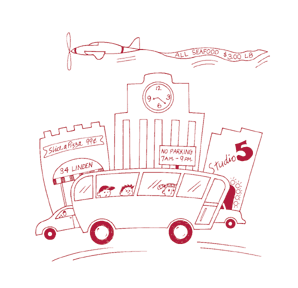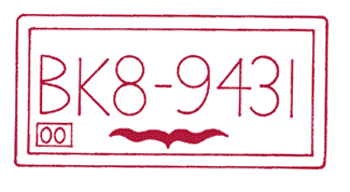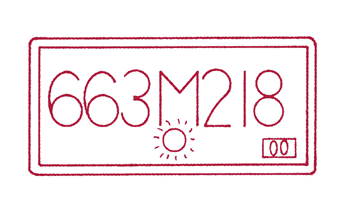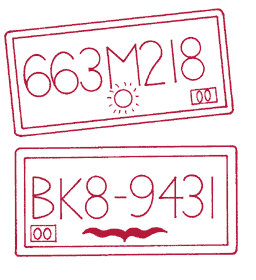|
|
|
Helping Your Child Learn Math - June
1999
Activities
 In
this busy world, we spend a lot of time moving from place to place in
our cars, on buses and trains, and on foot. Use your traveling time as
an opportunity to learn about math. Look around as you travel from place
to place, and help your child find numbers on buildings, buses, taxis,
and houses that they can add and subtract while on the road. Not only
will your child be learning and practicing math skills, but the time you
spend traveling will go by more quickly as well. In
this busy world, we spend a lot of time moving from place to place in
our cars, on buses and trains, and on foot. Use your traveling time as
an opportunity to learn about math. Look around as you travel from place
to place, and help your child find numbers on buildings, buses, taxis,
and houses that they can add and subtract while on the road. Not only
will your child be learning and practicing math skills, but the time you
spend traveling will go by more quickly as well.
Number Search
Grades K-3
What you'll need
Paper, pencil, and ruler
 What
to do What
to do
- Create a chart that lists the numbers from 1 to 50.
- Write down each number as family members locate that number on a
car, a sign, a building, or other objects in your community.
- Write down words that have numbers in them, such as "one-stop
shopping," "two-day service," "buy one, get one
free," or "open seven days a week."
| Parent Pointer |
 |
This activity provides children with lots of opportunities
to practice number recognition, as well as counting and writing
skills. |
License Plate Special
Grades 2-5
 What
you'll need What
you'll need
License plates, paper, pencil, and ruler
What to do
- Copy down a license plate number as you are traveling in your car,
walking around the neighborhood, or sitting on a park bench watching
cars go by. Read the license plate as a number (excluding the letters).
For example, if the license were 663M218, the number would be six hundred
and sixtythree thousand two hundred and eighteen.
- Find other license plates and read their numbers. Is the number less
than, greater than, or equal to yours?
- Estimate the difference between your number and another license plate.
Is it 10, 100, 1,000, or 10,000?
- Record the names of the states of many different license plates as
you see them. From which state do you see the most? Which has the fewest?
Prepare a chart or graph to show your findings.
| Parent Pointer |
 |
This license plate activity encourages reading, recognizing
numbers, noticing symbols, writing, counting, and graphing. |
License Plate Riddles
Grades K-5
 What
you'll need What
you'll need
License plates, paper, and pencil
What to do
- While traveling in a car, or on a bus, everyone watches for license
plates, focusing on one in particular for 5 minutes. The object is to
use the digits on the license plate to make the largest 3-digit number
possible. When a player chooses a license plate during the 5-minute
watching period, they call out the 3-digit number they have made from
the license plate. The person with the largest number wins the round.
Try the next round so the winner is the person with the smallest 3-digit
number.
- Let each letter on a license plate be worth the value of its position
in the alphabet. A= 1, M =13, Z = 26. Each person chooses a license
plate and adds the value of the letters. The person with the lowest
or the highest value wins the round.
- For younger children, this activity can be simplified by having them
find the largest single digit, or double digit, or even add all the
numbers on the license plate, or just recognize digits.
| Parent Pointer |
 |
This game helps children to develop their knowledge
of numbers and to think algebraically. |
Total It
Grades 3-5
What you'll need
License plates, paper, pencil, and calculator
What to do 
- As you are traveling in your car, or on a bus, each person takes
turns calling out a license plate number.
- All players try to add the numbers in their heads. Talk about what
strategies were used in the mental math addition. Were the numbers added
by 10's like 2+8? Were doubles like 6+6 added?
- Try different problems using the numbers in a license plate. For
example, if you use the plate number 663M218, ask "Using the numbers
on the plate, can you make 5?"
- 5 using two numbers? "Yes, 3+2 = 5"
- 5 using three numbers? "Yes, (3+2) x 1 = 5"
- 5 using four numbers? "Yes, (6+3+1) ÷ 2 = 5"
- 5 using five numbers? "Yes, (6+6+3) - (8+2) = 5"
- 5 using six numbers? "Yes, (6+6) + (3x1) - (8+2) = 5"
Try using a calculator to play these games. See if
you can solve these problems faster using the calculator.
| Parent Pointer |
 |
The problem-solving and computational skills your
child uses in this activity are very important to mental math skills,
and they also help your child to be creative with numbers. |
How Long? How Far?
Grades 1-3
 What
you'll need What
you'll need
Information about how far you're traveling and how long it will take
What to do
Many times when you are on the go, you are headed somewhere
that requires you to be there by a certain time.
- Ask your children how far they think you have traveled and how much
more you have to travel.
- Talk about how long it takes to get to your destination. If it is
3:15 now, and it takes 45 minutes to get there, ask if you will make
it for a 4:15 appointment? How much extra time will there be? Will we
be late?
| Parent Pointer |
 |
This car, bus, or train traveling exercise provides
many opportunities for children to use mental math and estimation
to calculate time and distance problems. |
Ease on Down the Road
Grades 2-5
 What
to do What
to do
- A gallon of gas costs $1.24 a gallon. What does it cost for 5 gallons?
10 gallons? 15 gallons? 20 gallons? What is an easy way to figure this
out? How can you estimate the cost by rounding the cost per gallon?
- The speed limit is 55 miles per hour. How far will you go in 1 hour?
Two hours? Three hours? How long will it take to go 500 miles?
Use a calculator to check your answers.
| Parent Pointer |
 |
An important algebra concept is finding relationships
between two quantities such as miles per hour or cost per gallon. |
[Math
at the Grocery Store] 
![[Table of Contents]](/parents/articles/pub_dom_images/up.gif)
 [Math
for the Fun of It] [Math
for the Fun of It] |
|
|

